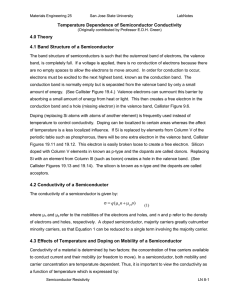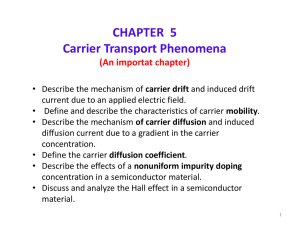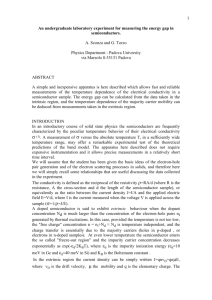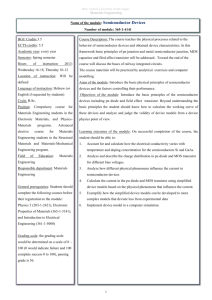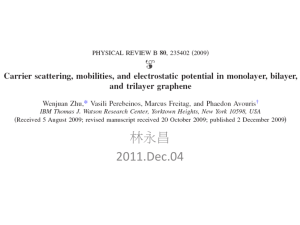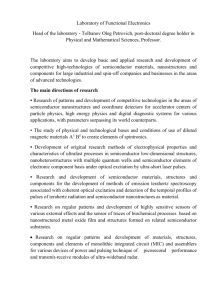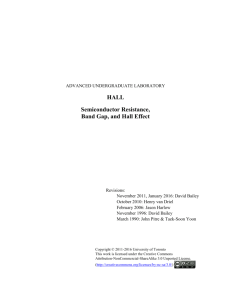Temperature Dependence of Semiconductor Conductivity
advertisement
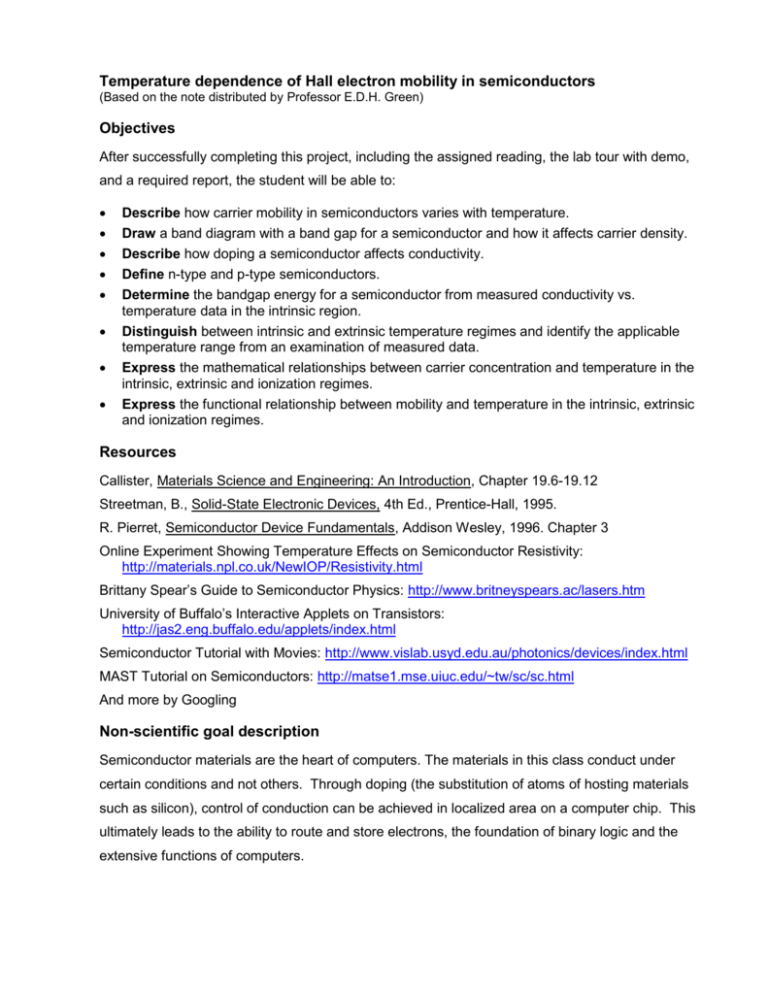
Temperature dependence of Hall electron mobility in semiconductors (Based on the note distributed by Professor E.D.H. Green) Objectives After successfully completing this project, including the assigned reading, the lab tour with demo, and a required report, the student will be able to: Describe how carrier mobility in semiconductors varies with temperature. Draw a band diagram with a band gap for a semiconductor and how it affects carrier density. Describe how doping a semiconductor affects conductivity. Define n-type and p-type semiconductors. Determine the bandgap energy for a semiconductor from measured conductivity vs. temperature data in the intrinsic region. Distinguish between intrinsic and extrinsic temperature regimes and identify the applicable temperature range from an examination of measured data. Express the mathematical relationships between carrier concentration and temperature in the intrinsic, extrinsic and ionization regimes. Express the functional relationship between mobility and temperature in the intrinsic, extrinsic and ionization regimes. Resources Callister, Materials Science and Engineering: An Introduction, Chapter 19.6-19.12 Streetman, B., Solid-State Electronic Devices, 4th Ed., Prentice-Hall, 1995. R. Pierret, Semiconductor Device Fundamentals, Addison Wesley, 1996. Chapter 3 Online Experiment Showing Temperature Effects on Semiconductor Resistivity: http://materials.npl.co.uk/NewIOP/Resistivity.html Brittany Spear’s Guide to Semiconductor Physics: http://www.britneyspears.ac/lasers.htm University of Buffalo’s Interactive Applets on Transistors: http://jas2.eng.buffalo.edu/applets/index.html Semiconductor Tutorial with Movies: http://www.vislab.usyd.edu.au/photonics/devices/index.html MAST Tutorial on Semiconductors: http://matse1.mse.uiuc.edu/~tw/sc/sc.html And more by Googling Non-scientific goal description Semiconductor materials are the heart of computers. The materials in this class conduct under certain conditions and not others. Through doping (the substitution of atoms of hosting materials such as silicon), control of conduction can be achieved in localized area on a computer chip. This ultimately leads to the ability to route and store electrons, the foundation of binary logic and the extensive functions of computers. Scientific (technical) background Band structure The band structure of semiconductors is such that the outermost band of electrons, the valence band, is completely full at 0 K. If a voltage is applied, there is no conduction of electrons because there are no empty spaces for electrons to allow/move around. In order for conduction to occur, electrons must be excited to the next highest band, known as the conduction band. The conduction band is empty at 0 K and is separated from the valence band by only an amount of energy, varying with different materials, for example Si at 1.10 eV and GaAs at 1.42. Valence electrons can surmount this energy gap/barrier by absorbing a certain amount of energy from heat or light. This then creates a free electron gas in the conduction band and a hole gas (missing electrons) in the valence band. Doping (replacing Si atoms with atoms of another element) is frequently used instead of temperature to control conductivity. Doping can be localized to certain areas whereas the affect of temperature is a less localized influence. If Si is replaced by elements from Column V of the periodic table such as phosphorous (P), there will be one extra electron in the valence band. This electron is easily broken loose to create a free electron. Silicon doped with Column V elements in known as p-type and the dopants are called donors. Replacing Si with an element from Column III such as boron (B) creates a hole in the valence band. The silicon is known as n-type and the dopants are called donors. Conductivity of a semiconductor The conductivity of a semiconductor is given by: q ( n n p p) (1) where µn and µp refer to the mobilities (see Prof. Shum’s note) of the electrons and holes, and n and p refer to the density of electrons and holes, respectively. A doped semiconductor, majority carriers greatly outnumber minority carriers, so that Equation 1 can be reduced to a single term involving the majority carrier. Effects of temperature and doping on mobility of a semiconductor As given in Eq. (1), conductivity of a material is determined by two factors: the concentration of free carriers available to conduct current and their mobility (or freedom to move). In a semiconductor, both mobility and carrier concentration are temperature dependent. Thus, it is important to view the conductivity as a function of temperature which is expressed by: q n T nT p T pT (2) There are two basic types of scattering mechanisms that influence the mobility of electrons and holes: lattice scattering (also called phonon scattering) and impurity scattering. We have already discussed lattice scattering in the class; we know that lattice vibrations cause the mobility to decrease with increasing temperature. However, the mobility of the carriers in a semiconductor is also influenced by the presence of charged impurities. Impurity scattering is caused by crystal defects such as ionized impurities. At lower temperatures, carriers move more slowly, so there is more time for them to interact with charged impurities. As a result, as the temperature decreases, impurity scattering increases and the mobility decreases. This is just the opposite of the effect of lattice scattering. The total mobility then is the sum of the phonon-scattering mobility and the impurity-scattering mobility. Figure 1 shows how the total mobility has a temperature at which it is a maximum. The approximate temperature dependence of mobility due to lattice scattering is T-3/2 , while the temperature dependence of mobility due to impurity scattering is T+3/2 (see Figure 1). In practice, impurity scattering is typically only seen at very low temperatures. In the temperature range we will measure, only the influence of lattice scattering will be expected. cm2 / V s (log scale) T 3 T 2 Impurity scattering 3 2 Lattice scattering T(K) (log scale) Figure1. Approximate temperature dependence of mobility with both lattice and impurity scattering Temperature dependence of carrier concentration (density) The carrier concentration in a semiconductor is also affected by temperature. The intrinsic carrier concentration can be calculated using the electronic density of states (DOS) and Fermi distribution (or approx. by Boltzmann distribution). By using Boltzmann distribution, the intrinsic carrier density is given by: 3 3 2 kT 2 E ni T 2 2 m*n m*p 4 exp g h 2kT (3) where the exponential temperature dependence dominates ni(T). It can be also proved the following relationship so called Mass Law: ni2 T n(T ) p (T ) (4) Where n(T) and p(T) are electron and hole densities. To determine the total carrier concentration, we must also consider space-charge neutrality condition: 2 ni T nT N D T N A nT and: n2i T pT N A T N D T pT (5) For a doped semiconductor, the temperature dependence of electron concentration can be seen in Figure 2. At very low temperatures (large 1/T), negligible intrinsic electron-hole-pairs (EHPs) exist (ni is very small), and the donor electrons are bound to the donor atoms. This is known as the ionization (or freeze-out) region. As the temperature is raised, increased ionization occurs and at about 100K all of the donor atoms are ionized, at which point the carrier concentration is determined by doping. The region where every available dopant has been ionized is called the extrinsic (or saturation) region. In this region, an increase in temperature produces no increase in carrier concentration. Referring to Equation 4, this is the region where N D T N D , N A T N A , and ni T N D N A . At high temperatures, the thermally generated intrinsic carriers outnumber the dopants (ni> N D N A ). In this intrinsic region, carrier concentration increases with temperature as shown in Equation 3 because ni has become the dominant term of Equation 5. Intrinsic 1017 1016 Extrinsic 1015 n0 (cm-1) Ionization 1014 1013 1012 1011 0 2 4 6 1000/T 8 10 12 (K)-1 Figure 2. Carrier concentration vs. reciprocal temperature for silicon doped with 1015 donors/cm3 Temperature dependence of conductivity for a semiconductor Remember that Eq.1 showed that conductivity depends on both carrier concentration and mobility, so there are a variety of possible temperature dependencies for conductivity. For instance, at fairly low temperatures (less than 200 K), the dominant scattering mechanism might be impurity scattering (T3/2) while the carrier concentration is determined by extrinsic doping (n = ND+), therefore, conductivity would be seen to increase with temperature (T3/2). Other possibilities, depending on the material, doping, and temperature will show different temperature dependence of conductivity. One particularly interesting case occurs at high temperatures (above 400K or higher) when carrier concentration is intrinsic (Equation 4) and mobility is dominated by lattice scattering (T-3/2). In such cases, the conductivity can easily be shown to vary with temperature as: exp Eg 2kT (6) In this case, conductivity depends only on the semiconductor bandgap and the temperature. In this temperature range, measured conductivity data can be used to determine the semiconductor bandgap energy, Eg. Experimental demo In this experiment we measure the resistivity and electron density of a germanium (Ge) sample as a function of temperature, from about 80 K up to about 580K, using a cryostat with a heating stage. A cryostat is an enclosure which can be cooled to very low temperature. The system is very easy to use and should work perfectly if you follow a few simple steps. Below is an outline to how the apparatus works, what you should expect to measure, and how to do it. The results will show the saturation region and the intrinsic region of conductivity. The temperature will not be low enough to observe the ionization (freeze) region. Cryostat apparatus The apparatus consists of a micro-miniature refrigerator (inside the small metal vacuum enclosure, which contains a window through which you can see the semiconductor sample), a tank of high pressure nitrogen for the refrigerating fluid, and a vacuum pump and manifold. The apparatus uses the Joule-Thompson expansion of a high pressure gas to achieve enough cooling to liquefy the gas in a small reservoir underneath the sample mount. The refrigerator is made up of a laminated set of glass slides, each of which has micro-channels etched into it, providing a serpentine path for the gas to go through a heat exchanger. The sample is mounted on a cold mount at the end of the refrigerator with thermal grease, which makes excellent thermal contact between the sample and the refrigerator. The sample can be cooled to 80 K from room temperature in about 10 minutes. The refrigerator also has a heater built in (thin wires) with which we can heat the sample or control the temperature stability. A Reference procedure Please use the instruction manual located next to each station; the instructions may have changed after this edition of the Lab-Notes was printed. 1. Close all valves V1, V2, V3, V4, on manifold. (See drawing located near instrument). 2. Switch on backing pump. (It may be on already.) 3. Connect vacuum meter to power. 4. Connect temperature controller to power. 5. Open valve V1 (this begins pumping on cryostat). 6. Watch the reading on vacuum meter. The pressure will begin to fall. 7. When the pressure drops to about 20 milli-torr, pass pure N2 gas at 500 psi to purge the system for about 10 minutes. 8. While purging, make the electrical connections. Connect the two leads at one end of Ge sample to terminals 1 & 4 of the terminal box, the other two leads at the other end of the sample to terminals 2 & 3. 9. To measure the resistance of the sample, connect 1 & 4 to high input terminals of the resistance meter, with 2 & 3 connected to the low input terminals of the meter. Meter will display resistance in Ohms (). 10. When the pressure in the system is close to 20 milli-torr, increase the N2 pressure to 1800 psi. This starts the sample cooling down to 80 K. 11. To control and read the sample temperature, use the Command box. It has the following commands: 12. Set the temperature to 80K, record the sample resistance 13. Set the temperature to 100K and record resistance 14. Repeat the measurement every 20 K until 540 K is reached. Do not exceed 560 K! 15. To stop the experiment 16. Press SK0 - Enter 17. Stop the gas flow (close main valve of N2 cylinder 18. Leave the backing pump ON 19. Turn on vacuum meter and resistance meter 20. To calculate the resistivity from the resistance, you need the sample dimensions from your instructor. After the experiment, answer the following questions: 1. What behavior did you observe in terms of temperature dependence of mobility and carrier concentration in the different regions of temperature? Identify the intrinsic, extrinsic, and ionization regions, if they appear. Plot the conductivity on a log or natural log scale. (Why?) 2. From the temperature of the transition between extrinsic and intrinsic behavior, estimate the dopant concentrations in the sample. 3. From the appropriate portion of your plot, calculate the bandgap energy (Eg) for germanium and compare to the published values. 4. Comment upon the accuracy of the results, cite and estimate possible sources of error. Reference data taking from a Ge sample (not sure n-type, p-type?) T(K) 130 135 140 145 150 155 160 165 170 175 180 185 190 195 200 205 210 215 220 225 230 235 240 245 250 255 260 265 270 275 280 285 290 295 300 302 304 306 308 R() 1200 1225 1250 1270 1290 1325 1362 1380 1420 1449 1485 1509 1537 1565 1590 1632 1662 1686 1720 1760 1793 1822 1865 1892 1920 1943 1975 1986 2000 2023 2046 2056 2066 2068 2060 2037 2022 2000 1978 T(K) 310 315 320 325 330 335 340 345 350 355 360 365 370 375 380 385 390 395 400 405 410 415 420 425 430 435 440 445 450 455 460 465 470 475 480 485 490 495 500 R() 1955 1866 1781 1630 1500 1421 1384 1300 1206 1104 1001 913 810 740 659 582 488 467 434 394 345 310 286 265 240 216 194 178 166 145 108 100 94 88 82 75 70 67 65
